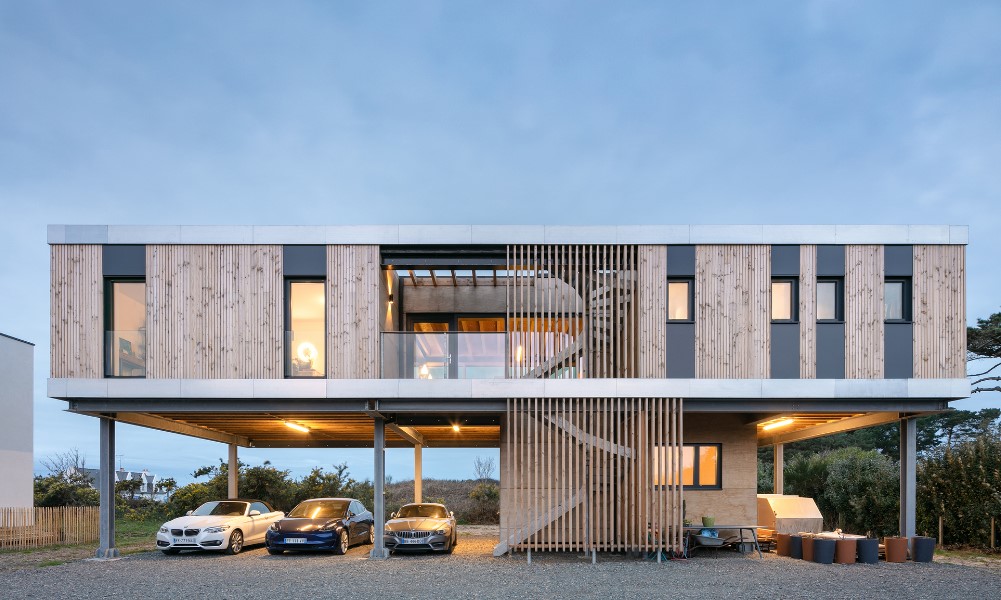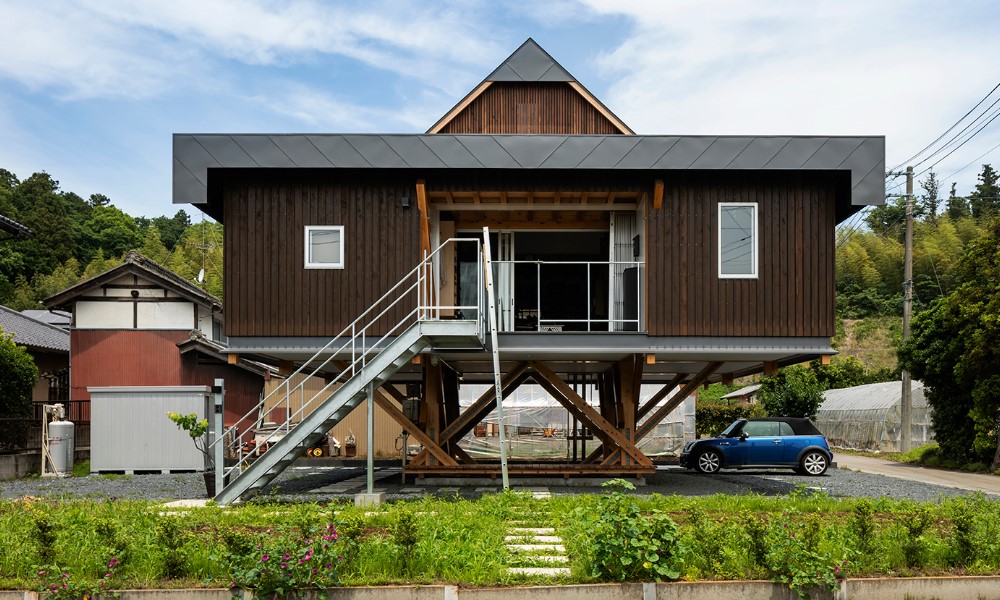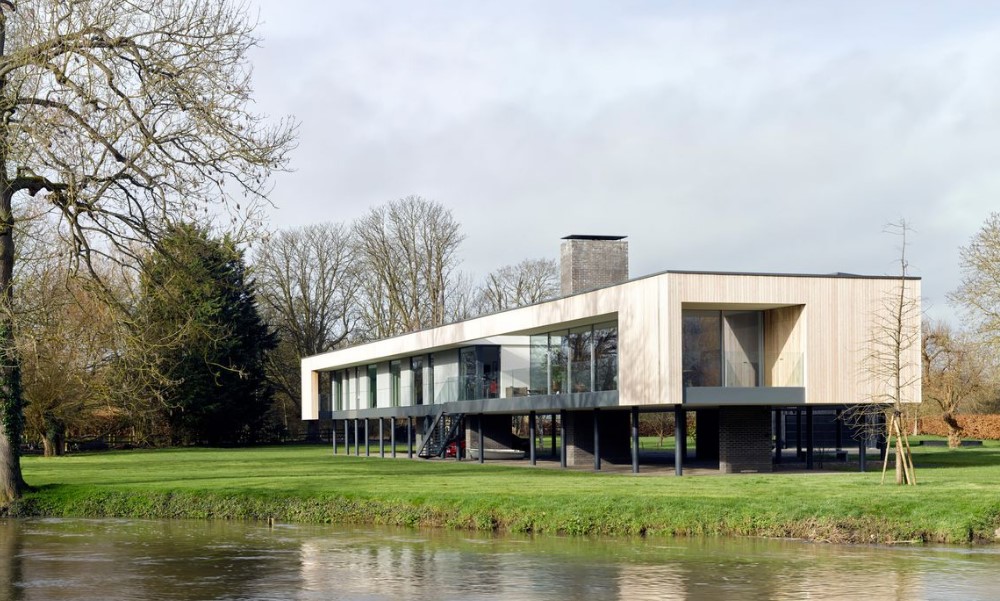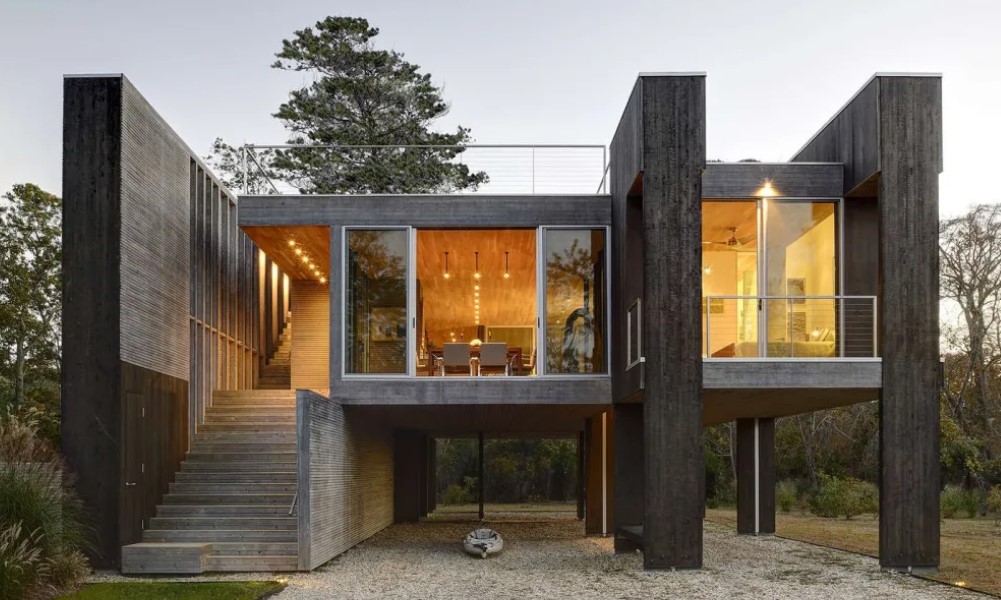Modern Stilt Houses: Key Features That Make Them Ideal for Coastal and Mountainous Regions
Modern stilt houses have gained popularity due to their versatility, aesthetic appeal, and functional design. These elevated structures are typically built on stilts or pilings, making them a perfect choice for areas prone to flooding, steep terrains, or coastal regions.
What is a Modern Stilt House?

A modern stilt house is a type of elevated structure that is built on long supports, or stilts, raising the living areas above ground level.
The main objective of this architectural design is to provide protection from natural elements, such as flooding, while maximizing the use of natural airflow and sunlight.
Modern stilt houses typically feature clean lines, large windows, open floor plans, and materials that contribute to a sustainable and eco-friendly living environment.
Key Features of Modern Stilt Houses

Modern stilt houses are designed to combine functionality with contemporary architectural aesthetics. They are primarily built to adapt to diverse terrains and environments, such as coastal areas, flood-prone regions, and sloped lands.
Below are the key features that define modern stilt houses and make them an ideal choice for various landscapes.
1. Elevated Design
One of the most prominent features of modern stilt houses is their elevation. These homes are built on stilts or pilings that raise the living space above ground level. This design is particularly beneficial in flood-prone areas or locations with high water tables.
The elevation provides a natural safeguard against flooding and water damage, while also offering better air circulation underneath the structure.
- Benefit: Protection against water damage and natural ventilation.
- Example: Coastal homes that remain dry during high tides or storm surges.
2. Sustainable Materials
Modern stilt houses are often constructed using eco-friendly and sustainable materials. These include bamboo, treated wood, prefabricated steel, and concrete, which are chosen for their durability, resistance to weather conditions, and environmental impact.
The use of these materials not only contributes to the house’s sustainability but also helps in reducing the carbon footprint of the construction process.
- Benefit: Long-lasting structures with minimal environmental impact.
- Example: Bamboo-framed stilt houses in tropical regions that resist insect infestations and weathering.
3. Adaptability to Terrain
One of the defining characteristics of stilt houses is their ability to be built on uneven or sloped land. This adaptability allows homeowners to construct their houses in areas where traditional homes may not be feasible, such as mountainsides or hilly landscapes.
The stilt foundation ensures that the structure remains level and stable, regardless of the terrain.
- Benefit: Flexibility to build on various landscapes.
- Example: Mountain cabins built on steep slopes without the need for extensive groundwork.
4. Natural Ventilation and Cooling
By elevating the house above the ground, modern stilt homes allow air to circulate freely beneath the structure. This natural airflow helps cool the home, reducing the need for air conditioning and making the house more energy-efficient.
The open floor plans and large windows commonly found in modern designs further enhance airflow and natural light.
- Benefit: Reduced energy consumption and improved indoor comfort.
- Example: Tropical stilt houses that remain cool without the use of air conditioning.
5. Scenic Views
The elevated design of stilt houses often results in unobstructed scenic views, making them ideal for coastal and mountainous regions. Whether built near the ocean or in a forest, the raised position allows homeowners to enjoy panoramic views of their surroundings.
- Benefit: Maximized views and privacy.
- Example: Beachfront stilt houses offering stunning ocean vistas from the living room.
Benefits of Modern Stilt Houses

Modern stilt houses provide several advantages, particularly for homeowners who live in challenging environments. Below are the key benefits that make this type of home appealing for a broad range of settings.
1. Flood Protection
The primary benefit of building a modern stilt house is protection against flooding. Homes built in flood-prone areas benefit greatly from the elevation provided by the stilts. By raising the home above potential water levels, you minimize the risk of water damage and provide a safer living environment for you and your family.
2. Energy Efficiency
Modern stilt houses often feature elevated structures that promote natural airflow beneath the house. This cooling effect reduces the need for air conditioning, making the home more energy-efficient. Additionally, many stilt homes are designed to maximize natural light, further reducing the need for artificial lighting during the day.
3. Scenic Views
Stilt houses are ideal for locations with scenic views, such as coastal areas or mountainous regions. The elevated design allows for an unobstructed view of the surroundings, offering a more immersive experience with nature. This is particularly beneficial for homeowners looking to make the most of their environment.
4. Adaptable to Various Terrains
Another major advantage of modern stilt houses is their adaptability to different types of landscapes. Whether the house is being built on a slope, near the beach, or on uneven terrain, stilt construction allows for more flexibility in terms of location. This versatility opens up a range of possibilities for homeowners who want to build in less conventional settings.
5. Sustainable and Eco-Friendly
Many modern stilt houses are built using sustainable materials, such as bamboo, recycled wood, or prefabricated steel. These materials reduce the environmental impact of construction and contribute to a greener living environment. Additionally, stilt houses that incorporate renewable energy solutions, such as solar panels, can further enhance their eco-friendly nature.
Top 5 Products for Building a Modern Stilt House

When constructing a modern stilt house, selecting high-quality materials is crucial to ensuring both the safety and longevity of the home. Below are five real-world products essential for building a durable and efficient modern stilt house, with detailed information on each one.
1. Simpson Strong-Tie Concrete Stilt Piers
Simpson Strong-Tie is a reputable brand known for providing high-strength concrete piers that form the base of stilt houses. These piers are critical for areas prone to flooding and are designed to withstand the elements, ensuring a strong foundation for your home.
- Use Case: Ideal for flood-prone or coastal areas where a strong, stable foundation is required.
- Advantages: Durable, weather-resistant, and offers excellent load-bearing capacity.
- Disadvantages: Installation requires professional expertise to ensure proper alignment.
- Price: $500 per unit
- Features: Corrosion-resistant, adaptable to varying heights.
Simpson Strong-Tie Concrete Stilt Piers
2. YellaWood Treated Lumber
YellaWood provides pressure-treated lumber that is perfect for constructing the framework of a modern stilt house. This treated wood is designed to resist decay, insect damage, and moisture, making it a durable choice for stilt house construction.
- Use Case: Suitable for constructing the main structure of stilt homes.
- Advantages: Pressure-treated for added durability, environmentally friendly options available.
- Disadvantages: Requires periodic maintenance and treatment to maintain its integrity.
- Price: $10 per linear foot
- Features: Insect and moisture-resistant, sustainable sourcing.
YellaWood Treated Lumber
3. Andersen Windows 100 Series
Andersen is a leading manufacturer of energy-efficient windows. The 100 Series offers composite windows that provide excellent thermal performance and are perfect for modern stilt houses, especially in areas with high exposure to the sun.
- Use Case: Ideal for maximizing natural light and providing energy efficiency in stilt houses.
- Advantages: Energy-efficient, durable, and customizable to fit modern designs.
- Disadvantages: Higher upfront cost compared to standard windows.
- Price: Starting at $250 per window
- Features: Composite materials, energy-efficient design, customizable sizes.
Andersen Windows 100 Series
4. EcoSteel Prefabricated Steel Frames
EcoSteel provides prefabricated steel frames that are both lightweight and strong, making them perfect for coastal homes where protection from harsh weather conditions is crucial. These frames are easy to assemble and offer corrosion resistance.
- Use Case: Suitable for stilt houses in areas with high wind or hurricane risks.
- Advantages: Lightweight, corrosion-resistant, and fast assembly.
- Disadvantages: Initial investment is higher than traditional materials.
- Price: Starting at $30,000 for a small home frame
- Features: High-tensile steel, custom designs available.
EcoSteel Prefabricated Steel Frames
5. SolarEdge Inverter & Solar Panels
For homeowners looking to integrate renewable energy into their stilt houses, SolarEdge offers high-efficiency solar panels and inverters. These systems allow you to harness solar energy to power your home, reducing reliance on traditional energy sources.
- Use Case: Perfect for generating renewable energy in modern stilt houses.
- Advantages: Reduces electricity costs, environmentally friendly.
- Disadvantages: Requires a sunny location for optimal performance.
- Price: $10,000 for a complete system
- Features: High-efficiency panels, energy storage options available.
SolarEdge Inverter & Solar Panels
Product Comparison Table
| Product | Use Case | Advantages | Disadvantages | Price | Features |
|---|---|---|---|---|---|
| Simpson Strong-Tie Concrete Piers | Strong foundation in flood-prone areas | Weather-resistant, durable | Needs professional installation | $500 per unit | High-strength concrete |
| YellaWood Treated Lumber | Building the stilt structure and framework | Long-lasting, eco-friendly | Requires maintenance | $10 per foot | Pressure-treated, insect-resistant |
| Andersen Windows 100 Series | Maximizing natural light | Energy-efficient, durable | Higher cost | $250 per window | Composite materials |
| EcoSteel Prefabricated Steel | Coastal homes withstanding strong winds | Corrosion-resistant, quick to assemble | Expensive | $30,000 frame | High-tensile steel |
| SolarEdge Inverter & Solar Panels | Renewable energy for the home | Reduces bills, eco-friendly | Needs sunny location | $10,000 system | High-efficiency, energy storage |
Uses Cases of Modern Stlit House
Modern stilt houses provide innovative solutions to a variety of environmental and geographical challenges. Their versatility makes them suitable for a wide range of uses in different landscapes. Below are some key use cases of modern stilt houses:
1. Flood-Prone Areas
One of the most common use cases for modern stilt houses is in regions prone to flooding, such as coastal areas, riverbanks, or regions with heavy rainfall. The elevated design ensures that the living space remains above the potential flood line, minimizing damage to the home. By lifting the structure above ground, stilt houses offer better protection against floodwaters compared to traditional foundations.
2. Coastal and Beachfront Properties
Stilt houses are particularly popular in coastal areas where high tides, storm surges, and erosion are a concern. Beachfront properties built on stilts allow homeowners to enjoy proximity to the ocean while protecting their homes from rising sea levels. Additionally, the elevated design provides panoramic views of the water, making them ideal for vacation homes or resorts.
3. Mountainous or Sloped Terrain
In hilly or mountainous regions, building on sloped land can be challenging. Modern stilt houses adapt to these uneven terrains by elevating the structure on stilts, eliminating the need for extensive land grading. This design allows homeowners to build homes on scenic slopes without disturbing the natural environment or risking structural instability.
4. Ventilation and Energy Efficiency
In hot climates, stilt houses allow air to circulate beneath the structure, providing natural cooling. This reduces the need for artificial cooling systems and promotes energy efficiency. The design is ideal for tropical regions where heat and humidity are common, as the airflow helps maintain a comfortable indoor environment.
Where to Buy Modern Stilt House Products
Purchasing the right materials is crucial for building a modern stilt house. Here are the best places to buy the top products mentioned in this article:
- Simpson Strong-Tie Concrete Stilt Piers: Simpson Strong-Tie Website
- YellaWood Treated Lumber: YellaWood Website
- Andersen Windows 100 Series: Andersen Windows Website
- EcoSteel Prefabricated Steel Frames: EcoSteel Website
- SolarEdge Inverter & Solar Panels: SolarEdge Website
FAQs
1. What are the primary materials used in modern stilt houses?
Modern stilt houses typically use treated wood, steel, and concrete for their construction. Many also integrate eco-friendly materials like bamboo or recycled steel.
2. Are stilt houses suitable for urban areas?
Yes, stilt houses can be designed for urban areas, especially in regions prone to flooding or where maximizing scenic views is important.
3. How much does it cost to build a modern stilt house?
The cost can vary widely depending on the materials, design, and location, but generally ranges from $150,000 to $500,000.
4. How energy-efficient are stilt houses?
Modern stilt houses can be very energy-efficient, particularly when designed with large windows for natural light, ventilation, and the use of renewable energy sources like solar power.
5. Can stilt houses withstand extreme weather conditions?
Yes, stilt houses, especially those built with strong materials like prefabricated steel frames and concrete stilts, are designed to withstand extreme weather conditions such as floods, high winds, and hurricanes.